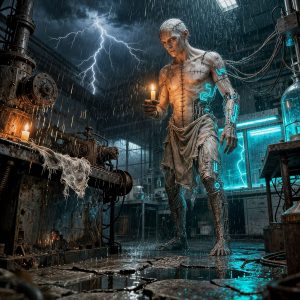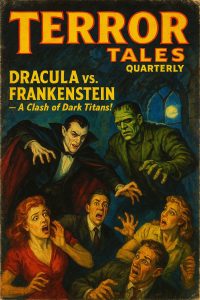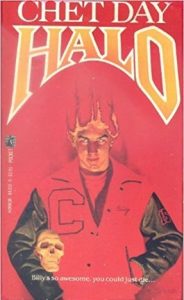If you want to understand modern horror fiction–the kind that kept readers up at night in the paperback boom of the 1970s and 80s, the kind I spent decades writing–you need to go back to two novels that essentially invented the genre as we know it: Mary Shelley’s Frankenstein (1818) and Bram Stoker’s Dracula (1897).

These aren’t just important because they’re old or because English professors love them. They’re important because every horror story written since, including the ones I’ve written, basically riffs on the templates these two novels established. They gave us the fundamental building blocks of fear.
Two Ways to Terrify
Frankenstein and Dracula represent two distinct approaches to horror that still define the genre today.
Shelley gave us the horror of human ambition gone wrong–we create our own monsters. Victor Frankenstein plays God in his laboratory, stitches together a creature from dead flesh, animates it with the spark of life, and then recoils in horror at what he’s made. The terror doesn’t come from outside; it comes from within, from our own hubris and our refusal to take responsibility for what we create.
Stoker gave us something different: ancient evil invading from the outside. Count Dracula isn’t something we created–he’s something that’s been lurking in the shadows for centuries, and now he’s coming for us. He represents the foreign, the other, the corruption that seeps into civilization from beyond its borders. The horror is that we’re vulnerable, that our modern world with all its science and reason can’t protect us from something that predates it.
Most horror fiction leans toward one of these poles or tries to blend them. Is the monster us, or is it them? Did we bring this on ourselves, or are we victims of something beyond our control?
My own work has always gravitated more toward the Frankenstein model–the horror that emerges from human choices and the consequences we can’t escape. In Halo, the real terror isn’t supernatural–it’s a sociopathic teenager enabled by institutions that refuse to see what he is. In The Hacker, a brilliant engineer literally becomes the monster when he uses experimental technology on himself. These are Frankenstein stories at their core: we create our own horrors, then refuse to take responsibility for them.
Making the Unbelievable Believable
Both novels understood something crucial about horror: if you want readers to believe in monsters, you have to make everything around the monsters feel absolutely real.
Shelley frames her story as a manuscript discovered by a sea captain who meets Victor Frankenstein in the Arctic. We get Victor’s first-person account, then the Creature’s own testimony embedded within Victor’s narrative. It’s like nesting dolls of authenticity–each layer makes the impossible story feel more grounded.
Stoker goes even further. Dracula is told entirely through journal entries, letters, newspaper clippings, ship’s logs, and phonograph recordings. It’s a documentary record of impossible events. We’re not being told a story; we’re being shown the evidence. The vampire is real because here are the eyewitness accounts, the medical reports, the telegram transcripts.
This technique–making horror feel documented, giving it the texture of found truth–became fundamental to the genre. From Lovecraft’s academic correspondence about forbidden knowledge to the found footage horror of The Blair Witch Project, we’ve been using variations on this approach for two centuries.
It’s a craft lesson that every horror writer learns: the more realistic and specific your details, the more your readers will accept the fantastic. Ground the impossible in the mundane, and you can get away with almost anything.
Sympathy for the Devil?
Here’s where these two novels diverge in fascinating ways.
Shelley’s Creature is articulate, self-aware, and desperately lonely. He reads Milton and Plutarch and he longs for companionship. He murders, yes, but only after being rejected and brutalized by every human he encounters. “I was benevolent and good; misery made me a fiend,” he tells Victor. We understand him. We might even sympathize with him. The real monster might be Victor, who abandoned his creation.
Dracula, on the other hand, is pure predator. He’s seductive, yes, and there’s an erotic charge to his attacks that made Victorian readers uncomfortable. But there’s no inner life here, no pathos, no redemption arc. He’s a threat to be destroyed, not understood. The novel’s heroes don’t try to reason with him or cure him–they hunt him down and drive a stake through his heart.
This gives us another fundamental split in horror: the monster you pity versus the monster you fear. The tortured soul versus the implacable evil. Literature has room for both, but they create very different stories.
I’ve written both kinds, though I’ll admit I’m drawn to the Creature’s side of things–monsters that are tragic, humans that are monstrous, and the murky territory where the two overlap.
The Victorian Laboratory
It’s not a coincidence that both these foundational horror novels emerged from the same cultural moment–Britain in the age of scientific advancement and social upheaval.
Shelley wrote Frankenstein in 1816, during the “Year Without a Summer,” holed up with Byron and other poets at the Villa Diodati in Switzerland. She was 18 years old, pregnant, and thinking about galvanism (the use of electricity to stimulate muscle tissue) and the implications of reanimation. What happens when science gives us the power to create life? What do we owe our creations?
Stoker published Dracula 79 years later, in an era of telegraphs, phonographs, blood transfusions, and psychiatric theories. His heroes use modern technology to fight ancient evil. They transcribe their experiences on wax cylinders, and they travel by train. They employ modern medicine and communication networks. Yet all this modernity can’t quite protect them from the vampire.
Both novels wrestle with the same anxiety: progress is powerful, but what if it can’t save us? What if we’re unleashing things we can’t control, or facing threats that our rational, scientific worldview can’t comprehend?
That tension–between the modern and the primitive, between reason and dread, between what we know and what we fear–remains central to horror fiction. It’s certainly central to mine.
The Road to Paperback Horror
So how do we get from these literary Gothic novels to the mass-market paperback horror that exploded in the 1970s and 80s, the stuff I was writing alongside hundreds of other pulp horror authors?
The line is more direct than you might think.

The Gothic tradition continued through the Victorian era with writers like Wilkie Collins and Robert Louis Stevenson. Then the pulp magazines of the early 20th century–Weird Tales, Black Mask, others–brought horror to a mass audience. Writers like H.P. Lovecraft and Robert E. Howard inherited Shelley and Stoker’s templates and made them stranger, more visceral, more American.
Then came the EC Comics of the 1950s–Tales from the Crypt and its siblings–bringing horror to visual life in ways that scandalized parents and delighted kids. The Hammer horror films of the 60s and 70s gave us technicolor blood and heaving bosoms, making Dracula sexy and Frankenstein’s creature sympathetic again.
By the time Stephen King published Carrie in 1974, the market was primed for paperback horror. And for the next two decades, publishers couldn’t print the stuff fast enough. Ancient evil in small towns. Demonic possession. Medical experiments gone wrong. Haunted houses. Serial killers. Creatures from beyond. All of it, everywhere, those distinctive painted covers screaming at you from wire racks in drugstores and supermarkets.
That was my world. That’s where novels like Halo were born–part of a massive wave of horror fiction that owed its existence to what Shelley and Stoker had figured out more than a century before.
The templates they created–human hubris unleashing horror, ancient evil invading the modern world, documentary realism making the impossible believable, monsters both tragic and terrifying—we were still using all of it. We just added more blood, more sex, more contemporary anxieties, and splashed it across those lurid covers.
Why This Still Matters
I’ve been thinking about these two classic novels lately because I’m experiencing something unexpected in my late 70’s–a second chance at reaching readers, thanks to Grady Hendrix featuring Halo in Paperbacks from Hell and a new generation discovering those old paperback horror novels.
When you’re trying to resurrect a career you thought was dead and buried, it helps to remember where the genre itself came from. Frankenstein and Dracula didn’t just survive–they’re more relevant now than ever. Film adaptations, television series, graphic novels, video games, endless reinterpretations and reinventions.
Maybe there’s hope for the rest of us pulp horror writers too.
In my next post, I’ll dig into what the masters of horror–King, Straub, Barker, and others–have said about the craft of writing fear. What techniques do they use? What do they think makes horror work?
And then in a third post, I’ll write about my own journey in the genre and what I’m learning as I try to bridge the pulp paperback era with something entirely new–collaborating with artificial intelligence to create horror fiction. It’s an experiment that’s proving far more difficult and fascinating than I expected.
But first, we need to understand the craft. And nobody’s better at explaining it than the writers who’ve scared millions of readers.
What horror novels have stayed with you over the years? I’d love to hear what scared you and why. Drop me a line through the contact page.
Hey, I’m 77 and I’ve got stories…
Stories about what it’s like to navigate life at this age (spoiler: it’s weird, wonderful, and occasionally terrifying). And stories about collaborating with AI to write books in ways that would have seemed like science fiction when I started putting words on paper. Stories about the daily realities, unexpected surprises, and hard-won wisdom that comes from three-quarters of a century on this planet. If you’re curious about authentic aging, writing innovation, or just enjoy good storytelling from someone who’s been around the block, subscribe to my weekly newsletter “Old Man Still Got Stories.” I promise to make it worth your time.
